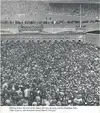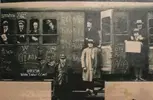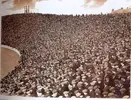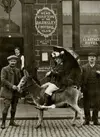summerisle
The rain, it raineth every day
http://www.victorianfootball.co.uk/victorian-football-attendance-evolution/
VICTORIAN FOOTBALL CROWDS AND GATES
 "The Miseries of Pleasure - Football and a Keen East Wind", Moonshine, 1895
"The Miseries of Pleasure - Football and a Keen East Wind", Moonshine, 1895
Around 2,000 spectators paid a shilling each to attend the first FA Cup final, between Wanderers and Royal Engineers, at the Oval in 1872. It was a large attendance in football terms, but but nothing compared to the 20,000 that international cricket matches could attract to the same ground. However, as our table below shows, football attendances grew along with the game's popularity as the Victorian era progressed.
FA Cup Final gates increased from 6,500 in 1882 to 22,000 in 1889. The 1892 final - the 20th at the Oval - drew a crowd of almost 33,000 spectators. After that, however, Surrey CCC decided that it could no longer allow football to damage its wickets. The final was moved to Fallowfield Stadium in Manchester, then Goodison Park in Liverpool, before finding a new permanent venue at the Crystal Palace. Almost 69,000 attended the FA Cup Final there in 1900.
The great occasion of the FA Cup final drew substantially higher crowds than top league matches. However, league attendances did increase steadily from the Football League's inception in 1888-89 through to the end of the Victorian era. Our table shows attendances for selected league matches between the two top-supported clubs of each season.

Overall, Everton were the top-supported Football League side of the Victorian era. For the first four league seasons, Everton played at Anfield, where they attracted average attendances of around 10,000. They were league champions in 1890-91, with the great Fred Geary the crowd’s goalscoring favourite. A move to Goodison Park in 1892 boosted average attendances to around 13,000, and within another five years they were up to around 17,500.
Everton had the highest average attendance of any club during the first 10 league seasons, only being surpassed towards the end of the era by Aston Villa, Newcastle United and Manchester City. Aston Villa had the highest average attendance of the 1899-1900 season of around 20,000.
VICTORIAN FOOTBALL CROWDS AND GATES

Around 2,000 spectators paid a shilling each to attend the first FA Cup final, between Wanderers and Royal Engineers, at the Oval in 1872. It was a large attendance in football terms, but but nothing compared to the 20,000 that international cricket matches could attract to the same ground. However, as our table below shows, football attendances grew along with the game's popularity as the Victorian era progressed.
FA Cup Final gates increased from 6,500 in 1882 to 22,000 in 1889. The 1892 final - the 20th at the Oval - drew a crowd of almost 33,000 spectators. After that, however, Surrey CCC decided that it could no longer allow football to damage its wickets. The final was moved to Fallowfield Stadium in Manchester, then Goodison Park in Liverpool, before finding a new permanent venue at the Crystal Palace. Almost 69,000 attended the FA Cup Final there in 1900.
The great occasion of the FA Cup final drew substantially higher crowds than top league matches. However, league attendances did increase steadily from the Football League's inception in 1888-89 through to the end of the Victorian era. Our table shows attendances for selected league matches between the two top-supported clubs of each season.

Overall, Everton were the top-supported Football League side of the Victorian era. For the first four league seasons, Everton played at Anfield, where they attracted average attendances of around 10,000. They were league champions in 1890-91, with the great Fred Geary the crowd’s goalscoring favourite. A move to Goodison Park in 1892 boosted average attendances to around 13,000, and within another five years they were up to around 17,500.
Everton had the highest average attendance of any club during the first 10 league seasons, only being surpassed towards the end of the era by Aston Villa, Newcastle United and Manchester City. Aston Villa had the highest average attendance of the 1899-1900 season of around 20,000.










